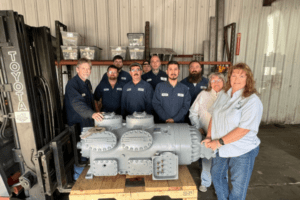Refrigeration compressors enable the refrigerant to circulate in the system. However, unlike air compressors, these parts cannot function independently of the refrigeration system.
How Do Refrigeration Compressors Work?
There are three physical phenomena that will help you understand how a compressor works:
1. Law of Thermodynamics
According to the Law of Thermodynamics, when a gas is compressed, its temperature increases. On the other hand, when gas is expanded, its temperature decreases.
2. Pure liquid temperature
When a pure liquid is compressed or boiled, its temperature remains constant. Gases also experience the same phenomena. When a gas is compressed, its temperature remains constant until the matter converts to a liquid.
3. Changing fluid phase
Finally, a more significant amount of energy is required to make a fluid undergo a phase change. For example, it takes more energy to change water into vapor than it takes to get the water from one temperature to another.
Commercial refrigerator compressors are different in structure and the way they work from other general-purpose compressors. Here are some ways in which the compressors are different:
- Commercial refrigerator compressors experience a wide range of changes in the suction
- The refrigerants used in the compressors are usually fluid and have a high permeability
- Sometimes, the refrigerant dissolves oils, making the lubrication ability of the compressor to deteriorate This occurs most often when the oil doesn’t match the refrigerant being used in the system
- Grocers are continuously looking for more powerful commercial refrigerant compressors, i.e., higher efficiency, increased lifetime, greater reliability, etc.
The Refrigeration Cycle
The refrigeration cycle is a continuous process that involves the movement of the refrigerant from the compressor to other parts of the refrigeration system. During the process, the refrigerant moves from the compressor to the condenser, before reaching the evaporator and starting the cycle again.
In the compressor, the refrigerant is compressed to a high-pressure gas. The compression increases the temperature of the gas.
From the compressor, the heated refrigerant passes to the condenser. The condenser has a colder fluid, usually ambient air, which cools the refrigerant. When the pressure is high, hot refrigerant is cooled, it condenses to a hot liquid. The liquefied hot refrigerant then leaves the condenser through the system’s metering device to an evaporator.
The metering device can either be a capillary tube or an expansion valve. When the liquefied refrigerant enters the metering device, its pressure drops and some of it vaporizes.
From the metering device, the cool refrigerant then enters the evaporator. In the evaporator, heat moves between the refrigerant and the device that should be cooled, i.e., the heat source. Generally, the heat source has a higher boiling point than the refrigerant. Therefore, inside the evaporator, the refrigerant is exposed to a higher temperature from the heat source, which makes it evaporate into a lower temp gas.
From the evaporator, the vaporized refrigerant goes back to the compressor, where the cycle repeats.
Main Types of Refrigeration Compressors
The major types of compressors used in refrigeration machines are:
1. Enclosed compressors
These compressors are angular (V- or W-shaped) or vertical in shape. The compressors have false cylinder covers, which protect them against the water-hammer effect. The compressors can be powered by either ammonia or freon.
2. Open-crankcase compressors
These horizontal compressors are double-action machines with pistons that move in opposite directions. The compressors can work on propylene, propane, or ammonia, while their cooling is done by water.
3. Screw compressors
There are two types of screw compressors; dry and oil-filled. These machines use one or two rotors to compress the refrigerant. Some of the common screw compressors that are available from Compressors Unlimited include the Carrier 06NA2250, the Trane CHHP0N2 and York DXS45.
4. Scroll compressors
Scroll compressors use two spirals (a moving one and a stationary one) to pump. The moving spiral is mounted on the eccentric while the stationary one is inside the compressor casing. The compressors are mainly used to compress oil-free gases. Compressors Unlimited is proud to offer the Danfoss SM and SH series of compressors including model numbers SM185 and SH380 compressors.
5. Turbochargers
Turbochargers are simply centrifugal compressors with a volumetric capacity of 50-60 m/min or more. The compressors are used in large cooling stations and refrigeration plants. These compressors are high-speed machines, averaging 13000 – 15000 rpm.
6. Hermetic compressors
Hermetic refrigeration compressors are located in the same housing with an electric motor that is directly cooled by the coolant. The compressors have a relatively small capacity of up to 35 kW.
7. Semi-hermetic compressors
These compressors are typically used in plants with large-capacity compact equipment. The compressors come in both screw and piston types. Semi-hermetic compressors are easy to remove and dismantle in case they have to be repaired. Some of the popular semi-hermetic compressor models offered by Compressors Unlimited include Carrier 06ET275360 and Copeland 3DB31000.
8. Open compressors
Open refrigeration compressors usually have an external motor. The compressors are mainly used in large industrial complexes, and typically have an oil seal or rotary seal. Compressors Unlimited is proud to provide our customers with quality remanufactured Carrier 5F and 5H models including 5F60 and 5H80.
Understanding how your refrigeration compressors work is crucial to detecting potential problems before they occur. Moreover, carrying out regular maintenance will ensure that the compressors are operating optimally.
The above is an overview of how compressors work and the major types of commercial refrigeration compressors available on the market.












